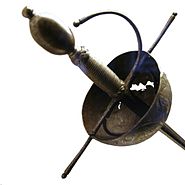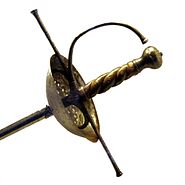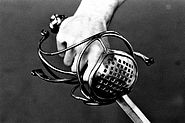| Rapier | |
|---|---|
 Rapier, first half of the 17th century. | |
| Type | Sword |
| Place of origin | Europe |
| Production history | |
| Designed | around 1500 |
| Specifications | |
| Mass | avg. 1 kg (2.2 lb) |
| Blade length | avg. 100 cm (39 in) |
| Width | avg. 2.5 cm (0.98 in) to sharp point |
|
| |
| Blade type | single or double edged, straight blade |
| Hilt type | complex, protective hilt |
A rapier is a slender, sharply pointed sword, ideally used for thrusting attacks, used mainly in Early Modern Europe during the 16th and 17th centuries.
Description[]

Rapier on display at Château de Chillon
The word "rapier" generally refers to a relatively long-bladed sword characterized by a complex hilt which is constructed to provide protection for the hand wielding it. While the blade might be broad enough to cut to some degree (but nowhere near that of the wider swords in use around the Middle Ages), the long thin blade lends itself to thrusting. The blade might be sharpened along its entire length or sharpened only from the centre to the tip (as described by Capoferro).[citation needed] Pallavicini,[citation needed] a rapier master in 1670, strongly advocated using a weapon with two cutting edges. A typical example would weigh 1 kilogram (2.2 lb) and have a relatively long and slender blade of 2.5 centimetres (0.98 in) or less in width, 1 metre (39 in) or more in length and ending in a sharply pointed tip.[citation needed]
The term rapier generally refers to a thrusting sword with a blade longer and thinner than that of the so-called side-sword but heavier than the small sword, a lighter weapon that would follow in the 18th century and later,[citation needed] but the exact form of the blade and hilt often depends on who is writing and when. It can refer to earlier spada da lato (much like the espada ropera) through the high rapier period of the 17th century through the small sword and duelling swords,[citation needed] thus context is important in understanding what is meant by the word. (The term side-sword, used among some modern historical martial arts reconstructionists, is a translation from the Italian spada da lato—a term coined long after the fact by Italian museum curators—and does not refer to the slender, long rapier, but only to the early 16th-century Italian sword with a broader and shorter blade that is considered both its ancestor and contemporary.)[citation needed]

Collection of early modern swords (17th to 18th centuries) at the George F. Harding Collection of Arms and Armor, the Art Institute of Chicago.
It is important to remember that the word "rapier" is a German word to describe what was considered to be a foreign weapon.[1] The word rapier was not used by Italian, Spanish, and French masters during the apogee of this weapon, the terms spada, espada and épée (or espée) being instead the norm (generic word for "sword"). Because of this, as well as the great variation of late-16th and 17th century swords, some like Tom Leoni simply describe the rapier as a straight-bladed, two-edged, single-handed sword of that period which is self-sufficient in terms of both offence and defence, not requiring a companion weapon.[citation needed] In order to avoid the confusion of lumping all swords together, some categorize such swords by their function and use. For example, John Clements categorizes thrusting swords with poor cutting abilities as rapiers and categorizes swords with both good thrusting and cutting abilities as cut and thrust swords.[2] Some however see the rapier in its entire time-line and see that it never truly fits into any single definition. Largely all over Europe the weapon changed based on culture and the fighting style that was prescribed; be it Italian, Spanish, or some other instruction on the weapon's use, so that lengths, widths, hilt designs and even the lack or placement of an edge or edges differed at the same time. One might wear a rapier with a swept hilt and edges on the same day as another might wear one with a cup hilt and an edgeless blade.
Parts of the sword[]
Hilt[]
Rapiers often had complex, sweeping hilts designed to protect the hand wielding the sword. Rings extended forward from the crosspiece. Later these rings were covered with metal plates, eventually evolving into the cup hilts of many later rapiers.[citation needed] Many hilts included a knuckle bow extending down from the crosspiece protecting the hilt, which was usually wood wrapped with cord, leather or wire. A fat pommel (often decorated) secured the hilt to the weapon and provided a balance to the long blade.
Blade[]
Various rapier masters divided the blade into two, three, four, five or even nine parts. The forte, strong, is that part of the blade closest to the hilt; in cases where a master divides the blade into an even number of parts, this is the first half of the blade. The debole, weak, is the part of the blade which includes the point and is the second half of the blade when the sword is divided into an even number of parts. However, some rapier masters divided the blade into three parts (or even a multiple of three), in which case the central third of the blade, between the forte and the debole, was often called the medio, mezzo or the terzo. Others used four divisions (Fabris) or even 12 (Thibault).
The Ricasso is that portion of the blade, usually unsharpened, which extends forward from the crosspiece or quillons and which is protected by the complex hilt.
Overall length[]
While there is room for debate as to how long a rapier should be, a common recommendation is to choose one such that the quillions (cross bars) are level with the navel (belly button) when standing naturally with the point resting on the ground.[3]
Off-Hand Weapons[]
Rapiers were often employed with off-hand bucklers, daggers, cloaks and even second swords to assist with defense.
History[]
The rapier began to develop around 1500 as the Spanish espada ropera, or "dress sword".[citation needed] The espada ropera was a cut-and-thrust civilian weapon for self-defense and the duel, while earlier weapons were equally at home on the battlefield. Its development began at a time period when the need for a lighter and faster sword became mandatory thanks to the introduction of firearm use in warfare .[4] Throughout the 16th century, a variety of new, single-handed civilian weapons were being developed, including the German Rapier,[citation needed] another cut-and-thrust weapon used for sportive fencing, as described in Joachim Meyer's Fechtbuch of 1570. 1570 is also the year in which the Italian swordmaster Signior Rocco Bonetti first settled in England advocating the use of the rapier for thrusting as opposed to cutting or slashing when engaged in a duel. Nevertheless, the English word "rapier" generally refers to a primarily thrusting weapon, developed by the year 1600 as a result of the geometrical theories of such masters as Camillo Agrippa, Ridolfo Capoferro and Vincentio Saviolo.
The rapier became extremely fashionable throughout Europe with the wealthier classes, but was not without its detractors. Some people, such as George Silver, disapproved of its technical potential and the dueling use to which it was put.
The etymology of the word rapier is uncertain. Charles du Fresne, sieur du Cange, in his Glossarium mediae et infimae Latinitatis, cites a form Rapperia in from a Latin text from 1511. He mentions an etymology deriving the word from the Greek ραπίζειν "to strike."[5] However, Walter William Skeat suggested that "rapiér" may derive from raspiére, a poker, and that this may be a contemptuous term developed by older cut-and-thrust fencers for the new weapon.[citation needed] The most probable root of this term, however, appear to be from the Spanish ropera that comes from ropa, or elegant dress, thus a "dress sword".
Allowing for fast reactions, and with a long reach, the rapier was well suited to civilian combat in the 16th–17th centuries. As military-style cutting and thrusting swords continued to evolve to meet needs on the battlefield, so did the rapier continue to evolve to meet the needs of civilian combat and decorum, eventually becoming lighter, shorter and less cumbersome to wear. This is when the rapier began to give way to the small sword.
By the year 1715, the rapier had been largely replaced by the lighter small sword throughout most of Europe, although the former continued to be used, as evidenced by the treatises of Donald McBane (1728), P. J. F. Girard (1736) and Domenico Angelo (1787). The rapier is still used today by officers of the Swiss Guard of the pope.[6]
Historical schools of rapier fencing[]
Italy[]
- Antonio Manciolino, Opera Nova per Imparare a Combattere, & Schermire d'ogni sorte Armi – 1531
- Achille Marozzo, Opera Nova Chiamata Duello, O Vero Fiore dell'Armi de Singulari Abattimenti Offensivi, & Diffensivi – 1536
- Anonimo Bolognese, L'Arte della Spada (M-345/M-346 Manuscripts) – (early or mid 16th century)[7][8] date it to "about 1550"[9][10]
- Camillo Agrippa, Trattato di Scientia d'Arme con un Dialogo di Filosofia – 1553
- Giacomo di Grassi, Ragion di Adoprar Sicuramente l'Arme si da Offesa, come da Difesa – 1570
- Giovanni dall'Agocchie, Dell'Arte di Scrimia – 1572
- Angelo Viggiani dal Montone, Trattato dello Schermo – 1575
- Marco Docciolini, Trattato in Materia di Scherma – 1601
- Salvator Fabris, De lo Schermo ovvero Scienza d'Armi – 1606
- Nicoletto Giganti, Scola overo Teatro – 1606
- Ridolfo Capo Ferro, Gran Simulacro dell'Arte e dell'Uso della Scherma – 1610
- Francesco Alfieri, La Scherma di Francesco Alfieri – 1640
- Giuseppe Morsicato Pallavicini, La Scherma Illustrata – 1670
- Francesco Antonio Marcelli, Regole della Scherma – 1686
- Bondi di Mazo, La Spada Maestra – 1696
Spain[]
- Jerónimo Sánchez de Carranza, De la Philosofia de las Armas (1569)
- Luis Pacheco de Narváez, Libro de las Grandezas de la Espada (1599)
- Girard Thibault, Academie de l'Espee, ou se demonstrant par Reigles mathematiques, sur le fondement Cercle Mysterieux (1630)
France[]
- André Desbordes, Discours de la théorie et de la pratique de l'excellence des armes (1610)
- François Dancie, Discours des armes et methode pour bien tirer de l'espée et poignard (c.1610) and L'Espee de combat (1623)
- Charles Besnard, Le maistre d'arme liberal (1653)
England[]
- Vincentio Saviolo, His Practise 1595
- Joseph Swetnam, The Schoole of the Noble and Worthy Science of Defence (1617)
- The Pallas Armata (1639)
Germany[]
Main articles: German school of swordsmanship
- Paulus Hector Mair, Opus Amplissimum de Arte Athletica (1542)
- Joachim Meyer, Thorough Descriptions of the free Knightly and Noble Art of Fencing (1570)
- Jacob Sutor, Künstliches Fechtbuch (1612)
- Johannes Georgius Bruchius (1671)
The classical fencing tradition[]
Classical fencing schools claim to have inherited aspects of rapier forms in their systems. In 1885, fencing scholar Egerton Castle wrote "there is little doubt that the French system of fencing can be traced, at its origin, to the ancient Italian swordsmanship; the modern Italian school being of course derived in an uninterrupted manner from the same source." Castle went on to note that "the Italians have preserved the rapier form, with cup, pas d'ane, and quillons, but with a slender quadrangular blade."[11]
Popular culture and entertainment[]
- Despite the rapier's common usage in the 16th–17th centuries, many films set in these periods (many starring Errol Flynn) have the swordsmen using épées or foils. Actual rapier combat was hardly the lightning thrust and parry depicted. Director Richard Lester and fight choreographer William Hobbs attempted to more closely match traditional rapier technique in Three Musketeers and The Four Musketeers.[12] Since then, many newer movies, like The Princess Bride and La Reine Margot have used rapiers rather than later weapons, although the fight choreography has not always accurately portrayed historical fencing techniques. Rapiers are also often featured in various video games, in particular Role-playing games set in the medieval and Renaissance periods.
- The television series Queen of Swords features the use of the rapier in the mysterious circle, Destreza style favoured by the first swordmaster of the series Anthony De Longis who studied the Spanish sword fighting technique and wanted a unique style for the heroine.[13] He had previously used it in the episode, "Duende", of the Highlander TV series.
See also[]
- Espada ropera, a dueling sword from Spain
- European dueling sword for a more detailed explanation of the primary use of the rapier for dueling
- Historical European Martial Arts
Literature[]
- Clements, John (1997). Renaissance Swordsmanship: The Illustrated Book Of Rapiers And Cut And Thrust Swords And Their Use. Paladin Press. ISBN 978-0-87364-919-3. http://books.google.com/books?id=-9YBAAAACAAJ&dq=Renaissance+Swordsmanship:+The+Illustrated+Book+Of+Rapiers+And+Cut+And+Thrust+Swords+And+Their+Use.
- Kirby, Jared (2004). Italian Rapier Combat: Ridolfo Capo Ferro. Greenhill Books. ISBN 978-1-85367-580-5. http://books.google.com/books?id=NE-UHgAACAAJ&dq=Italian+Rapier+Combat:+Ridolfo+Capo+Ferro.
- Leoni, Tom. The Art of Dueling: 17th Century Rapier as Taught by Salvatore Fabris. Highland Village, TX: The Chivalry Bookshelf, 2005. ISBN 978-1-891448-23-2
- Leoni, Tom (2010). Venetian Rapier: The School, or Salle. Nicoletto Giganti's 1606 Rapier Fencing Curriculum.. Freelance Academy Press. ISBN 978-0-9825911-2-3. http://www.freelanceacademypress.com/venetianrapier.aspx.
- Wilson, William E (2002). Arte of Defence: An Introduction to the Use of the Rapier. Highland Village, TX: The Chivalry Bookshelf. ISBN 978-1-891448-18-8. http://www.chivalrybookshelf.com/titles/AoD/AoD.htm.
- Windsor, Guy (2006). Duellists Companion: A Training Manual for 17th Century Italian Rapier. Highland Village, TX: The Chivalry Bookshelf. ISBN 978-1-891448-32-4. http://books.google.com/books?id=8vXoAAAACAAJ&dq=Duellists+Companion:+A+Training+Manual+for+17th+Century+Italian+Rapier.
Notes[]
- ↑ Meyers, Joachim (1570). A Thorough Description of the Free Knightly and Noble Art of Combat with All Customary Weapons.
- ↑ Clements, John (1997). Renaissance Swordsmanship: The Illustrated Book Of Rapiers And Cut And Thrust Swords And Their Use. Paladin Press. ISBN 978-0-87364-919-3. http://books.google.com/books?id=-9YBAAAACAAJ&dq=Renaissance+Swordsmanship:+The+Illustrated+Book+Of+Rapiers+And+Cut+And+Thrust+Swords+And+Their+Use.
- ↑ Thibault, Girard (1630). Academie de l'Espée.
- ↑ "Weaponry: The Rapier". Historynet.com. 2006-06-12. http://www.historynet.com/weaponry-the-rapier.htm. Retrieved 2013-01-13.
- ↑ Du Cange, Glossarium mediae et infimae Latinitatis, s.v.:
- RAPER, Gladius longior et vilioris pretii, Gallice Raper. Monstræ Factæ apud Chassagniam: Claudius Jornandi habet unam bonam Rapperiam et unam dagam. Ducit Borellus a Græco ῥαπίζειν, Cædere.
- Raper adjective sumitur, in Lit. remiss. ann. 1474, ex Reg. 195. Chartoph. reg. ch. 1155: Icellui Pierre donna au suppliant de ladite espée Raper sur la teste, etc.
- ↑ [1][dead link]
- ↑ Rubboli and Cesari (2005) date this work to 1500-1525. Leoni and Reich of the Order of the Seven Hearts
- ↑ "Salvatorfabris.com". Salvatorfabris.com. http://www.salvatorfabris.com/. Retrieved 2013-01-13.
- ↑ 2006 class handout[dead link]
- ↑ Chicagoswordplayguild.com[dead link]
- ↑ Castle, Egerton (1885). Schools and Masters of Fence: From the Middle Ages to the Eighteenth Century.. London: George Bell & Sons. pp. iv, 257. http://books.google.com/books?id=XgYHAAAAQAAJ&printsec=frontcover&dq=Schools+and+Masters+of+Fence#PPP1,M1.
- ↑ The Three Musketeers (1973)
- ↑ Behind the scenes Destiny page 1
External links[]
| Wikimedia Commons has media related to Rapiers. |
- "Translation of Charles Besnard's treatise of 1653" by Rob Runacres
- "Translation of François Dancie's manuscript of c.1610" by Rob Runacres
- "An Introduction to the Rapier Techniques of Salvator Fabris" by Phil Marshall
- "Call to Arms: The Italian Rapier" by Bill Grandy
- "Questions and Answers About the Rapier" by John Clements
- "Replication of Rapier Fencing Today" by John Clements
- "Italian Rapier – The Weapon"[dead link]
by Tom Leoni
- "The Rapier of Gustav Vasa, King of Sweden" by Björn Hellqvist
- "Rapier and cloak vs rapier and dagger" with Rob Runacres of Commilitium Historical Fencing
- YouTube – Rapier vs longsword A Sparring bout between Nick Thomas and Michael Thomas of the Academy of Historical Fencing
- "The Sword becoming the Rapier. Part 2." Description and photos.
| ||||||||||||||||||||||||||||||||||||||||||||||||||||||||||||||||||||||||||||||||||||||||||||||||||||
The original article can be found at Rapier and the edit history here.







